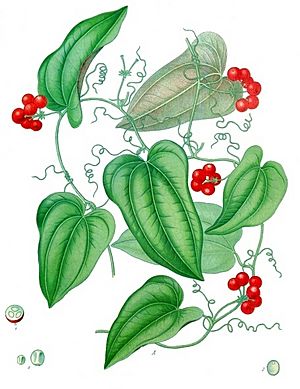Gray sarsaparilla facts for kids
Quick facts for kids Gray sarsaparilla |
|
|---|---|
 |
|
| gray sarsaparilla | |
| Scientific classification | |
| Genus: |
Smilax
|
| Species: |
aristolochiifolia
|
| Synonyms | |
|
|
Sarsaparilla (scientific name: Smilax aristolochiifolia) is a cool plant found in Mexico and Central America. People also call it gray sarsaparilla or Mexican sarsaparilla. It belongs to the Smilax group of plants and the Smilacaceae family. For a long time, people have used sarsaparilla in traditional medicine.
Contents
What Sarsaparilla Looks Like
Sarsaparilla is a climbing plant that grows year after year. It has thin branches and can reach about 4 to 5 meters (13 to 16 feet) tall. The plant uses special parts called tendrils to climb up trees.
Its leaves are like paper, but also feel a bit leathery. They are arranged one after another along the stem. Each leaf is about 10 to 30 centimeters (4 to 12 inches) wide. The stems are smooth and have thorns at the joints.
Flowers and Berries
Sarsaparilla has small green flowers. These flowers are round and have separate male and female parts on different plants. They grow in small bunches of about 12 flowers.
Later, the plant produces small red berries. Each berry usually has 2 or 3 seeds inside. These berries appear in late summer or fall. They stay on the plant through winter, providing food for animals and birds. When animals eat the berries and then poop, the seeds spread and help new sarsaparilla plants grow.
Roots of the Plant
The roots of sarsaparilla are long and deep. They can grow about 2 to 2.5 meters (6.5 to 8 feet) into the ground. These roots are usually brownish-gray to black. They have a stiff surface and some small rootlets growing from them. Even if most of the roots are cut, the plant can still grow new, thinner roots a few years later.
Where Sarsaparilla Grows
Sarsaparilla loves to grow in wooded areas. This is because it needs trees to climb on using its tendrils. You can often find it in warm, wet, or swampy places. It also grows in high places, like mountains. For example, in Nuevo León, Mexico, it's found at 1,760 meters (5,774 feet) high.
Where Sarsaparilla is Found
This plant is native to Mexico and Central America. It grows especially well in the Mesoamerica region. This includes countries like Belize, El Salvador, and Guatemala.
In North America, sarsaparilla is mainly found in southern Mexico. You can see it in states such as Tabasco, Veracruz, Yucatán, Nuevo León, Puebla, Oaxaca, and Quintana Roo. In El Salvador, it grows in a place called Hacienda San José, Santa Ana.
How People Use Sarsaparilla
Sarsaparilla in Food
The roots of the sarsaparilla plant are used to add flavor to many things. They can be found in drinks, like old-fashioned root beer. They are also used in dairy desserts, baked goods, and candies. The taste of the root itself is a mix of sweet and bitter.
Sarsaparilla in Traditional Medicine
For a long time, people have used sarsaparilla roots in traditional medicine. They believed it could help with many health issues. Some people used it as a general tonic to feel stronger or to help with skin problems.
It was also thought to help with digestion and make people feel hungrier. Some people even used it to help build muscle. In New Guinea, local people used the stem of sarsaparilla to help with toothaches.
It's important to know that while sarsaparilla has been used traditionally, scientists are still studying its effects. Taking too much of it can be harmful.
Sarsaparilla's Natural Chemicals
Sarsaparilla roots contain natural compounds called saponins. These saponins are interesting because they are similar to some chemicals used to make medicines like cortisone. Scientists believe saponins might help the body absorb other helpful substances more easily.
The plant also has other natural chemicals. These include organic acids, flavonoids, and plant sterols like sitosterol and stigmasterol. Scientists continue to study these compounds to understand their full effects.
The Name Sarsaparilla
The plant is also sometimes called Smilax medica or Smilax aristolochiaefolia. In Spanish, common names include zarzaparilla, cocolmeca, and alambrilla.
The name "Sarsaparilla" comes from Spanish words. "Zarza" means "bramble" or "bush," "parra" means "vine," and "illa" means "small." So, sarsaparilla means "a small bushed vine."

